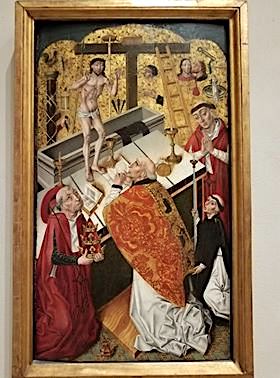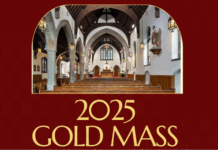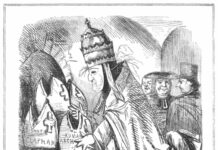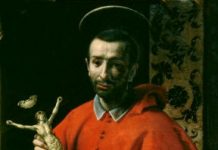
For my house shall be called a house of prayer for all peoples (Is. 56: 7).
In any given region or country, a common language is a source of unity. You may be familiar with the term lingua franca or bridge language, a language used to make communication possible between people who do not share a common language. Not long ago, it was the French language that served this purpose certainly in the world of diplomacy; hence the expression, lingua franca. Today, it would seem that English has become the common language of the world community.
My house shall be called a house of prayer for all peoples (Is. 56: 7). The prophecy of Isiah is fulfilled in our hearing. We too have common language; a universal language with particular accents. I don’t mean literally a language, although Latin is the official language of the Roman Rite. The universal language of the Catholic Church is the unity and integrity of faith that binds us together as one people. The accents of this common language might be understood as the practices of piety or liturgical celebrations that may be particular to a given local Church, the artistic expressions in whatever forms that celebrate the one faith, but the language, the faith is universal and indeed unchanging.
A sacred or ritual language helps to safeguard this unity and so does the ritual or rite itself. An example of this is the Holy Mass of the Traditional Roman Rite, sometimes referred to as the Gregorian or Tridentine Rite. This rite can be traced back to the apostolic age; its form is intimately connected with the decades in which Christianity was established. In the sixteenth century the missal of the Roman pope which since late antiquity had never succumbed to heretical attack, was prescribed for universal use by Catholic Christendom throughout the West. The Traditional Roman Rite faithfully and unequivocally expressed the Christian faith: that God the Creator took on the form of man, His creature. In Christ Our Saviour, the whole fullness of deity dwells bodily, and [we] have come to fullness of life in him (Col. 2:9-10). The Christian Rite, of which the Roman Rite is an ancient part, thus became an incessant repetition of the Redemptive Incarnation; the re–presentation in time of the one, eternal Sacrifice of Our Lord on Calvary.
My house shall be called a house of prayer for all peoples (Is. 56: 7). The vision of the Prophet Isaiah alludes to our understanding of the Church as a sacrament of unity. God has gathered together as one all those who in faith look upon Jesus as the author of salvation and the source of unity and peace, and has established them as the Church, that for each and all she may be the visible sacrament of this saving unity (Lumen Gentium, 9). Just as Jesus, Way, Truth and Life is our way to the Father; so the Church in which Our Lord is present performing His saving work, is the way that leads us to God. Since God cannot be seen or heard directly, He conveys His summoning Word and inviting sign in a form that is audible, concrete and visible. This is what the Church is; and specifically, this is what the Mass is: an ancient form that is audible, concrete and visible. The form of the Mass is not arbitrary or inconsequential and as Catholics we must discover anew the treasure of our sacred Tradition, in our day, defend it and appreciate that the Mass invites us to a lifetime of education because in the presence of this Mystery, one has never learned everything there is to learn.
Authentic Christian discipleship is a free response and embrace of the Cross leading to a participation in its mystery. Whoever does not carry his own cross and come after me cannot be my disciple (Lk. 14:27). Our Lord has left us the Mass as the Memorial of His Sacred Passion and our reverent celebration of the Holy Sacrifice is in and of itself the most effective form of evangelization. The sacred liturgy is the vehicle of faith, that is, the means by which the faith is communicated. It may be said that the traditional sacred liturgy is one of the riches of the poor. In our churches, rightly ordered, in the holiness of beauty, all of us, whatever our state, can have an experience of shared transcendence, a glimpse on this side of the veil, of the glory that awaits those who seek and love God. And the foreigners who join themselves to the Lord, to minister to him, to love the name of the Lord and to be his servants, all who keep the Sabbath…these I will bring to my holy mountain, and make them joyful in my house of prayer (Is. 56:6-7). These words are fulfilled in the communion that is the Catholic Church, whose faith is unchanging – regardless of what we may hear or even be told. The Church of Christ, the Catholic Church embraces all the families of the peoples, and the Eucharist which makes us one with Christ Our Lord, conforms us to His image on earth.
Growth in God’s own likeness or holiness is the effect of true worship. This is especially brought about in Eucharistic Adoration, an extension of the Holy Sacrifice of the Mass. It is in this form of prayer that is intimately personal, quiet and sober that the work of our transformation in Christ is most effectively effected. It is an invitation to spiritual maturity and sobriety and refinement of life. St. Peter Julian Eymard, (+1868) whose feast we celebrated at the beginning of August is known as the Apostle of the Eucharist. His writings are a great help to deepening our understanding of the Mass and of the Most Blessed Sacrament of the Altar. When the Saint established houses of public Eucharistic Adoration, he insisted that these be cenacles be oases not only of prayer, but also of beauty. He wrote:
The Gospel tells us…that [for the Last Supper] Jesus chose a ‘large furnished room.’ What an astonishing thing! Jesus always sought out poor houses and here we find a kind of sumptuousness. For the Eucharist, nothing is too beautiful! May this also be our firm conviction. For the Eucharist, nothing is too beautiful! May we strive always to deepen our love for the Blessed Sacrament and build up our lives on the Reality of Our Lord’s Eucharistic Presence.










